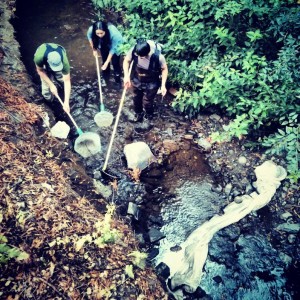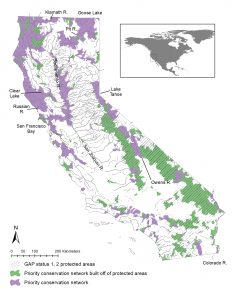Current research and extension interests include:
Environmental flow science and policy
River ecosystem health and aquatic biodiversity are rapidly declining in California and around the world. A significant contributor to freshwater degradation is unsustainable management of river systems, especially the modification of timing of peak flows and flow reductions from dams and diversions. In recent years, significant advances have been made in understanding effects of hydrologic alteration on river ecosystems, identifying ecological flow requirements, and developing frameworks to conjunctively manage water for human and ecosystem benefits. However, securing environmental flows (i.e., water allocations for the environment) remains a challenge because of competition with other water users as well legal and institutional barriers. Furthermore, scientific uncertainty in predicting ecological responses to flow alteration (and managed environmental flows) has hindered the establishment and implementation of environmental flow policies.
Previous research has focused on the development and testing of watershed hydrologic models to evaluate alternative management scenarios and quantify tradeoffs among environmental flow objectives and water supply security for individual water users (Grantham et al. 2010, Grantham et al. 2014). Current research involves statistical modeling approaches to predict flows at engaged streams (e.g., Grantham et al. 2022, Eng et al. 2017), assess the flow alteration (e.g., Zimmerman et al. 2017), and quantify ecological responses to flow alteration at regional and national scales (e.g., Carlisle et al. 2017). Our research group is also conducts field studies to directly evaluate the effects of flow alteration on aquatic habitat, fish behavior, and survival (e.g., Vander Vorste et al. 2020).
To advance the science and implementation of environmental flows in California, we are also contributing to studies on California water management with the Water Policy Center of the Public Policy Institute of California and engaging with State and Federal agencies through a Environmental Flows Workgroup of the California Water Quality Monitoring Council. A key product of this workgroup is the California Environmental Flows Framework, a guidance document and repository of tools and resources to inform development of environmental flow recommendations in rivers and streams throughout the state (Stein et al. 2021).
Climate change risk assessment and adaptation
Climate change is rapidly altering the global water cycle, challenging society’s ability to sustainably manage water both for people and for aquatic ecosystems and species. Addressing these challenges requires an improved understanding of how climate change will affect the water cycle and the underlying vulnerabilities of socio-ecological systems. Our lab is involved in research and extension activities that address both of these dimensions.
Research is focused on the development of ecological resilience indicators (e.g., Grantham et al. 2019) and application of analytical frameworks, such as Eco-Engineering Decision Scaling, or EEDS, to assess and communicate the potential impacts of climate change on freshwater resources (Poff et al. 2015). This risk assessment approach is embedded within a larger climate-informed decision-support system, developed by the Alliance for Global Water Adaptation network (AGWA), which incorporates economic-finance, hydro-climatic, and governance aspects. Learn more about EEDS here and on a ClimateReady podcast (Ep. 9, part 1 and part 2)!
Extension activities are focused on building the capacity of California’s cooperative extension system to support climate adaptation planning and action. For example, through UC ANR’s Climate Change Program Team, we conducted a survey of extension professionals in California to better understand if and how they incorporate climate change in their work (results were reported in a California Agriculture article). We also host workshops focused on “Integrating Climate Change in California Cooperative Extension.”
Cannabis and the environment
For decades cannabis has played an important role in many California communities, providing income to rural residents, driving patterns of land use change, and increasing pressures on natural resources including water. Recent legalization and regulation of cannabis production and consumption in California is an unprecedented change in public policy and may have profound impacts on the environment and communities across the state. At this moment of change there is a need for scholarship on cannabis-producing communities and their relation to the natural environment.
In 2018, we established Cannabis Research Center at UC Berkeley. Our goal is to promote interdisciplinary scholarship on the social and environmental dimensions of cannabis production. Through scientific research and engagement with community, government, and academic entities, we advance understanding of cannabis agriculture in socio-ecological systems at local, national, and global scales. We seek to inform public dialogue and contribute to the development of prosperous communities and healthy environments. Read more about our research at our website and a recent special issue in California Agriculture.

Systematic freshwater conservation planning
Freshwater ecosystems and biodiversity are in decline worldwide and are disproportionately imperiled relative to terrestrial systems. In California, a growing population and the transformation of natural hydrologic systems have degraded and reduced aquatic and wetland habitats to a small fraction of their historic extent, threatening the existence of many freshwater-dependent species. Despite the widespread and severe degradation of aquatic systems there is currently no statewide plan for managing California’s freshwater biological diversity.
An on-going research focus, in collaboration with researchers at UC Davis, The Nature Conservancy and several state agencies, is to promote systematic conservation planning for the management of California’s freshwater ecosystems and freshwater-dependent species. This research involves compiling geospatial data of freshwater-dependent species (Santos et al. 2014; Howard et al. 2015) and using conservation planning approaches to identify priority watersheds that disproportionately contribute to regional taxonomic diversity (Grantham et al. 2016; Howard et al. 2018). An overriding objective of the effort is to institutionalize freshwater conservation within decision-making of natural resource managers. Thus, technical aspects of the work have been coupled with efforts to engage key personnel from relevant state and federal water management agencies, including the Department of Fish and Wildlife Service, US Fish and Wildlife Service, State Water Resources Control Board, and Forest Service, and to integrate our work with internal agency planning efforts that affect resource-allocation decisions.
